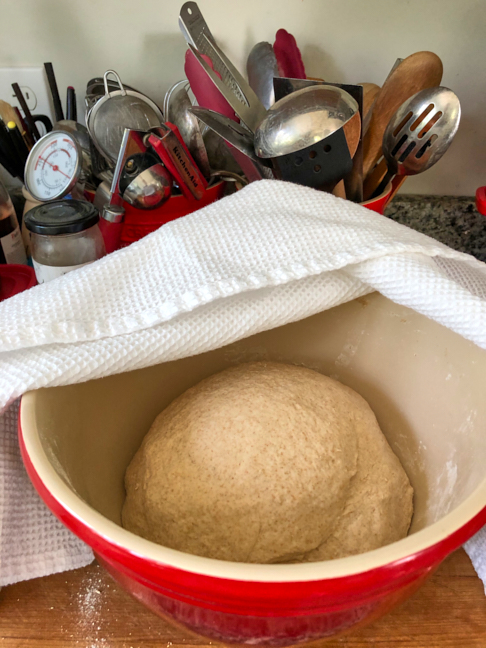Sourdough Adventures in Confinement
Notes from a French Kitchen
By Marie-Christine Perry

As strange as it is for Frenchwomen to tackle bread making, seeing as we are never more than a half block away from a great bakery in French towns and even small villages have their own bakers with pain au levain available everywhere, I had dabbled in trying my hand at whole wheat bread and the like when I lived in Northern California, with pretty good results. I started working at a small French crêperie in San Francisco, Le Mistral, and our almost-next-door neighbor was the Tassajara bakery, provider of great baguettes and assorted baked goods, so my urge to bake bread quickly died off.
Over the years the urge returned, particularly as my son Stéphane proved to be very interested in cooking and baking. We even acquired, to his delight, a bread-making machine, and I would wake up to the heady aroma of the loaves he concocted.
Sourdough bread started to become available in the U.S., giving birth to the craze of making “artisan bread in five minutes a day.” I purchased books and read them – from Rose Levy Baranbaum’s “The Bread Bible” to San Francisco French baker Pascal Rigo’s “The American Boulangerie,” from King Arthur Flour’s “Baker’s Companion” to Maggie Gleze’s “A Blessing of Bread: The Many Rich Traditions of Jewish
Bread Baking Around The World”- but did not experiment much.
We had recently discovered that Cheryl, my partner, was gluten intolerant, so I took a class about gluten-free baking at the Culinary Institute of America in Hyde Park, NY. The course only touched lightly on bread baking, and the complex list of ingredients needed did not make baking worthwhile. Sporadically buying the lonely baguette when bread craving hit became my modus operandi. However, I continued baking scones and madeleines, with the occasional flourless chocolate cake.
Then came Covid confinement. As flour quickly disappeared from shelves everywhere, I was able to score two 25-pound bags of King Arthur Flour at Costco, and thus the sourdough bread baking saga commenced. Building the sourdough starter day after day required discipline ─ retract two cups from the starter and add one cup of flour and one cup of water to it every day for about ten days ─ and left me with abundant starter castoffs, which provided countless sourdough crêpes and sourdough crackers, sourdough cinnamon buns and sourdough waffles. I tried quite a few recipes, looking for that perfect pain au levain with only flour, water, starter and salt, and kept finding most bakers added other ingredients.
I had just purchased Apollonia Poilâne’s new book about bread baking, “Poilâne”, named after her father’s legendary bakery in Paris, which had been the provider of many pains aux noix and pains au levain during my life as an art student there. And I found the perfect recipe! There it was, on page 50. Poilâne-Style Sourdough! In Apollonia’s words: “This recipe produces a loaf similar to our sourdough, with a chewy, sweet sour crumb and a chocolate brown crust that crackles when sliced.”
I baked that dough as a very large round pain de campagne, and feasted on it for a few days. This was the bread of my childhood. Memories flooded my mind, of the fougasse baked in the wood oven of my grandparents’ village in the Quercy, eaten still hot in large torn chunks; of similar loaves crackling when sliced and eaten, lathered with sweet butter and jam for our children’s afternoon “goûter”. Heaven made bread!
